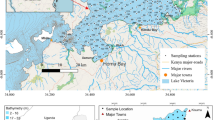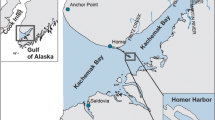Abstract
The Tri-State Mining District (TSMD) is a historic mining area containing the Tar Creek superfund site and is the source for sediment-bound metals in Grand Lake. Despite elevated concentrations of cadmium, lead, and zinc, no evidence of sediment toxicity has been observed during previous investigations; however, these studies were limited to lake transects with mostly deep-water sediments. The purpose of this study was to assess whether TSMD-specific sediment toxicity thresholds (STTs), developed for small streams and tributaries draining the TSMD, are predictive of biological effects within the greater lake body. Investigations focused on determining trace metal distribution within the northern reaches of Grand Lake, emphasizing shallow water areas (≤ 6-m depth), and the effects of sediment disturbance on trace metal bioavailability and toxicity to two freshwater invertebrates. No significant mortality or differences in growth occurred under natural or disturbed sediment conditions for either aquatic invertebrate despite using some sediments that exceeded both McDonald general sediment quality guidelines (SQGs) and TSMD-specific STTs. Although the simulated disturbance event (i.e., vigorously aerating sediments for 30 days before toxicity tests) was sufficient to increase trace metal water concentrations and detection frequencies, no changes in overall sediment load, bioavailability, or toxicity were observed following a 10-day exposure duration. These results suggest that TSMD-specific STTs could be used to evaluate Grand Lake sediments that could potentially be disturbed by boat traffic, wave action, and dredging associated with dock construction as opposed to the more conservative general-SQGs.



Similar content being viewed by others
References
Atkinson CA, Jolley DF, Simpson SL (2007) Effect of overlying water pH, dissolved oxygen, salinity and sediment disturbances on metal release and sequestration from metal contaminated marine sediments. Chemosphere 69:1428–1437
Besser JM, Brumbaugh WG, Hardesty DK, Hughes JP, Ingersoll CG (2009) Assessment of metal-contaminated sediments from the Southeast Missouri (SEMO) mining district using sediment toxicity tests with amphipods and freshwater mussels. US Geological Survey, Columbia Environmental Research Center, Columbia Missouri. Administrative Report 08-NRDAR-02
Burks SL, Wilhm J (1995) Diagnostic and feasibility study of Grand Lake O’ the Cherokees: Phase 1 of a Clean Lakes Project
Calmano E, Hong J, Forstner U (1993) Binding and mobilization of heavy metals in contaminated sediments affected by pH and redox potential. Water Sci Technol 28:223–235
Campbell PGC (1995) Interactions between trace metals and organisms: critique of the free-ion activity model. In: Tessier A, Turner DT (eds) Metal speciation and bioavailability in aqautic systems. Wiley, London, pp 45–102
Chapman PM, Wang F, Janssen C, Persoone G, Allen HE (1998) Ecotoxicology of metals in aquatic sediments: binding and release, bioavailability, risk assessment and remediation. Can J Fish Aquat Sci 55:2221–2243
Di Toro DM, Allen HE, Bergman H, Meyer JS, Paquin PR, Santore RC (2001) Biotic ligand model of the acute toxicity of metals. 1. Technical basis. Environ Toxicol Chem 20:2383–2396
Eggleton J, Thomas KV (2004) A review of factors affecting the release and bioavailability of contaminants during sediment disturbance events. Environ Int 30:973–980
Finney DJ (1971) Probit analysis. Cambridge University Press, Cambridge
Garvin EM, Bridge CF, Garvin MS (2017) Screening level assessment of metal concentrations in streambed sediments and floodplain soils within the Grand Lake watershed in Northeastern Oklahoma, USA. Arch Environ Contam Toxicol 72:349–363
Harbaugh JW (1957) Mississippian bioherms in Northeastern Oklahoma. Bull Am Assoc Pet Geol 41(11):2530–2544
Horowitz AJ, Stephens VC (2008) The effects of land use on fluvial sediment chemistry for the conterminous US—results from the first cycle of the NAWQA program: trace and major elements, phosphorus, carbon and sulfur. Sci Total Environ 400:290–314
Ingersoll CG, Wang N, Hayward JMR, Jones JR, Jones SB, Ireland DS (2005) A field assessment of long-term laboratory sediment toxicity tests with the amphipod Hyalella azteca. Environ Toxicol Chem 24:2853–2870
Ingersoll CG, Ivey CD, Brumbaugh WG, Besser JM, Kemble NE (2009) Toxicity of sediments from the Grand Lake O’ the Cherokees with the amphipod Hyalella azteca. Administrative Report CERC-8335-FY09-20-01
Ingersoll CG, Kunz JL, Hughes JP et al (2015) Relative Sensitivity of an amphipod Hyalella azteca, a midge Chironomus dilutes, and a unionid mussel Lampsilis siliquoidea to a toxic sediment. Environ Toxicol Chem 34:1134–1144
Landrum PF, Lydy MJ, Eadie BJ (2013) Dynamics of contaminant accumulation in benthos: route to understanding exposure to organic contaminants. Environ Toxicol Chem 32:1209–1211
MacDonald DD, Ingersoll CG, Berger TA (2000) Development and evaluation of consensus-based sediment quality guidelines for freshwater ecosystems. Arch Environ Contam Toxicol 39:20–31
MacDonald DD, Smorong DE, Ingersoll CG et al (2009) Development and evaluation of sediment and pore-water toxicity thresholds to support sediment quality assessments in the Tri-State Mining District (TSMD). Missouri, Oklahoma
McCormick CA, Burks SL (1987) Bioavailability and toxicity of extracts from acid-mine-waste-contaminated sediments. Proc Okla Acad Sci 67:31–37
OECD, guidelines for the testing of chemicals No. 233. 2010. Sediment-water chironomid life-cycle toxicity test using spiked water or spiked sediment
Paquin PR, Gorsuch JW, Apte S et al (2002) The biotic ligand model: a historical overview. Comp Biochem Phys C 133:3–35
Reichenberg F, Mayer P (2006) Two complementary sides of bioavailability: accessibility and chemical activity of organic contaminants in sediments and soils. Environ Toxicol Chem 25:1239–1245
USEPA (United States Environmental Protection Agency) (1999) Field sampling guidance document: Sediment Sampling. US EPA Region IX, Richmond, CA. SOP #1215, Revision 1
USEPA (United States Environmental Protection Agency) (2000) Methods for measuring the toxicity and bioaccumulation of sediment-associated contaminants with freshwater invertebrates. 2nd edn. (EPA-600/R-99/064)
USEPA (United States Environmental Protection Agency) (2002) Methods for measuring the acute toxicity of effluents and receiving waters to freshwater and marine organisms. 5th edn. (EPA-821-R-02-012)
USEPA (United States Environmental Protection Agency) (2007a) Method 3051A: Microwave assisted acid digestion of sediments, sludges, soils, and oils. US EPA SW-846 Chapt. 3.8, Revision 1
USEPA (United States Environmental Protection Agency) (2007b) Method 6010C: Inductively coupled plasma-atomic emission spectrometry. US EPA SW-846 Chapt. 3.9, Revision 3
USEPA (United States Environmental Protection Agency) (2017) National Recommended Water Quality Criteria—Aquatic Life Criteria Table. Accessed Online: November 2017. https://www.epa.gov/wqc
Acknowledgements
The authors claim no conflict of interest for this research. This project was partially funded by a student fellowship through the Grand River Dam Authority and was conducted in conjunction with the Oklahoma State University Water Quality Research Laboratory. This manuscript was improved based on the comments of two anonymous reviewers.
Author information
Authors and Affiliations
Corresponding author
Electronic supplementary material
Below is the link to the electronic supplementary material.
Rights and permissions
About this article
Cite this article
Morrison, S., Nikolai, S., Townsend, D. et al. Distribution and Bioavailability of Trace Metals in Shallow Sediments from Grand Lake, Oklahoma. Arch Environ Contam Toxicol 76, 31–41 (2019). https://doi.org/10.1007/s00244-018-0559-1
Received:
Accepted:
Published:
Issue Date:
DOI: https://doi.org/10.1007/s00244-018-0559-1




